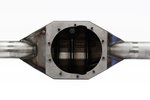How Much Winch Line Will Fit on Your Winch?

- All About Winch Cable
- Why You Shouldn't Use Chain for Off Road Recovery
- The Winch Recovery Kit Comparison Guide
- Get a winch extension strap
- Get a winch land anchor
- Get one of the high-strength, small-diameter winch lines. They are more expensive than regular synthetic but you get more line on the drum in a smaller diameter.
- Drum inside width: 8.125"
- Drum diameter: 3.5"
- Cable wrapping diameter: 6.75"
- Winch cable diameter: 3/8"
Don't make your winch line too long! There are two problems with a too-long winch line.
First, a winch works harder the more wraps there are one the drum. This means that when your winch line is mostly spooled up it's less powerful than when most of the line is played most of the way out. This is because of the increase in distance from the drum to the outer layer of the rope. Lay your arm on a table with 5 lbs in your hand and lift your hand while keeping your elbow on the table. Now tape the 5 lbs to a broomstick and tape the broomstick to your arm. It'll be much harder with the object of movement much further away. Winch line length is a compromise between ability to reach anchors and power.
Second, more winch cable means that you can jam up your winch more easily. For example, if you do an extreme side pull for an extended period you'll end up with a pile of cable on the side of the drum. This can damage your cable and damage your winch if you continue to reel in while your cable or rope is jammed.
If you really need more cable length you have three options:
Winch Cable or Synthetic Rope Length Calculator
If you're going to calculate how much cable you can fit on a winch drum, you're going to need to do 5 minutes of measuring.
Winch drum diameter: If you can slip a thin ruler between the winch cable and the winch drum's flange (maybe wedging the cable a little with a screw driver), you can probably measure the height of the flange, multiply by 2, and subtract it from the overall flange diameter that you measure with a tape measure.
Cable wrapping diameter: This will be a little in from the edge of the drum flange. If you get too much cable on your drum you'll decrease pulling strength when you have a lot of cable on the drum and you risk jamming the cable up during recovery.
We tested the calculator with a stock Warn M12000. It has these dimensions:
The calculator returned 126 feet, which is quite close to the factory specified length of 125 feet.
We measured the cable wrapping diameter by measuring in from the top of the drum flange to the top of the cable. This was 1/2". To account for the whole diameter we multiplied by 2 and subtracted it from the winch flange diameter.

Note particularly that the winch cable wrapping diameter is not at the outer edge of the flange! On an M12000, the factory wrapping diameter was 1/2" in from the edge of the drum flange, or 1" smaller in diameter than the drum flange.
Winch Cable and Synthetic Rope Length Formula
If the calculator above didn't work for you for some reason (please let us know!) you can use the below formula with any values that you want. The drum width, cable wrapping diameter, drum, diameter, and rope diameter should all be in inches. The rope length will be in feet.
Last updated: September 5, 2019







